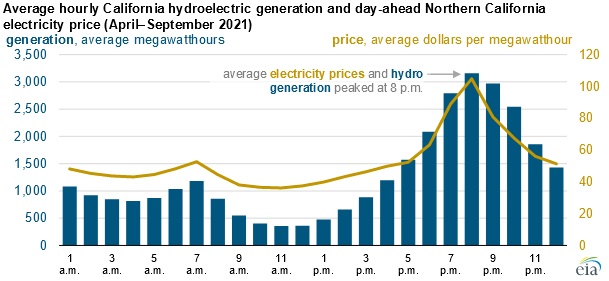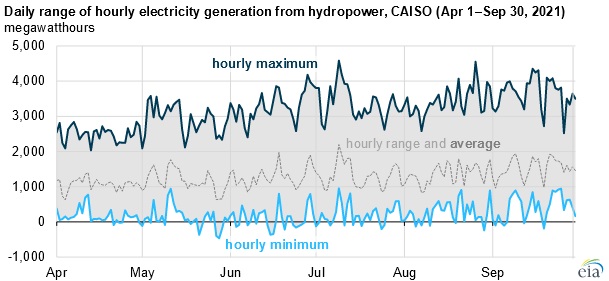
Source: Graph by the U.S. Energy Information Administration, based on data from the California Independent System Operator (CAISO).
Despite widespread, intense drought conditions, hydroelectric power plants in the California Independent System Operator (CAISO), the grid operator for most of the state, provided a significant amount of generation from April to September 2021. Although drought conditions reduced the water supply in California, hydroelectric generation during this period still increased in response to the higher average hourly electricity prices in the late afternoon.
So far in 2021, monthly generation from hydroelectric plants in California has been near the bottom of its 10-year range. To maximize revenue, hydroelectric plants must concentrate their generation into the hours of the day when electricity demand and, therefore, prices are highest, typically between 6:00 p.m. and 9:00 p.m.
Hydroelectric generators provided an average of 5% of the total generation in CAISO from April to September 2021. During the peak-priced hour, however, that share jumped to 10% of total generation, making hydro the third-largest source of electricity after natural gas and electricity imports from other grid operators in California and out of state. Price data are based on the day-ahead electricity price for the NP-15 generation pricing hub in Northern California, where most hydroelectric capacity in California is located.
Operating a hydroelectric power plant is complicated. These plants are subject to regulatory, environmental, and recreational requirements, as well as physical storage limitations and the interconnected nature of operating units within a watershed. The impact of these constraints on hydroelectric generation is increased by the sustained drought, which limits the availability of water. To conserve limited water resources for use during the highest-priced hours of the day, hydropower plants submit economic bids, or schedules, to generate in California's wholesale electric market.
Hydroelectric generation varies significantly by day and by hour. From April to September 2021, daily output from hydroelectric plants in CAISO averaged over 30,000 megawatthours (MWh) per day, ranging from a low of nearly 15,000 MWh to a high of more than 52,000 MWh. The maximum hourly hydroelectric generation each day ranged from more than 2,000 MWh to over 4,500 MWh. As a result of limited water availability, the maximum output level can only be sustained for one or two hours per day.

Source: Graph by the U.S. Energy Information Administration, based on data from the California Independent System Operator (CAISO)
Note: Hydroelectric generation includes hydroelectric pumped storage, resulting in negative hourly minimum values for some hours.
Hydroelectric generation includes generation from hydroelectric pumped storage power plants. These plants pump water into a storage reservoir when electricity demand and prices are low, such as during the night. The plants then release water down through a generator during times of the day when prices and demand are high. Pumping water uphill can involve significant electricity use, resulting in negative hourly hydroelectric generation for some hours.
Principal contributor: M. Tyson Brown









